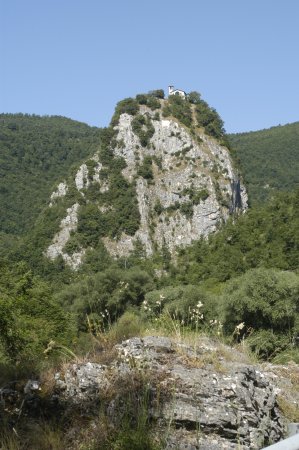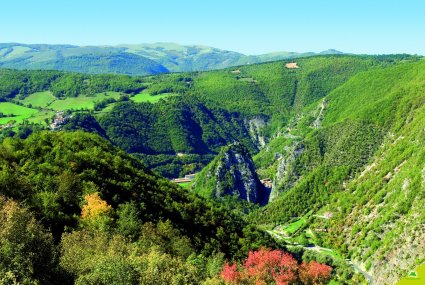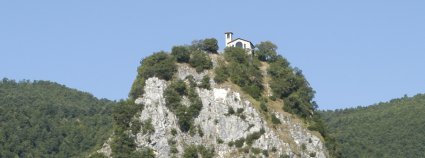A trip to Roccaporena for the annual Festa delle Rose e delle Rite on June 22nd can be an ideal opportunity to discover the little known but spectacular natural landscape of this area. Along the Corno and Tissino basins an itinerary runs from Roccaporena towards the Medieval hamlet of Monteleone di Spoleto and continues for Poggiodomo and Cerreto di Spoleto.
Along with its strategic position between the Valle del Corno and the Valle del Tissino, a number of important archaeological digs have confirmed that Roccaporena has been inhabited for thousands of years. Today the village is known primarily as a place of pilgrimage, attracting hosts of faithful who come here to venerate the so-called “Scoglio di Santa Rita”, a large oblong-shaped rock believed to have the marks of St Rita’s knees and elbows.
 |
The lower section of the mountain on which Roccaporena stands slopes far more gently than the upper part, with a northwards-running river that passes rocky crags sprouting up through fields and farmland stretching down to the water’s edge. In some places the water runs through canyon-like gorges, offering a dramatic contrast to this Arcadian landscape. It is immediately after one of these narrow gorges that the river runs along the Sacred Rock of Roccaporena and then flows eastwards past the steep slopes of Monte della Sassa (mt 1131) towards Cascia. This area, along with a number of other places in the central and southern Italian Apennines, as well as in parts of Sicily and Sardinia, is the last remaining home to a small bush that has survived since the Tertiary Age: the Ephedra Nebrodensis.
A number of other interesting plant species grow along the course of the river Corno, such as white willow, Alnus Glutinosa, elm and walnut, with the small fields in the valley below punctuated by the silhouettes of poplar trees. The woodland of this area is composed primarily of ilex and carpinus, which grow at irregular density according to the steepness and exposition of the slopes that house them. The slopes that run from Roccaporena towards Cascia face northwards and, even at fairly low altitude, contain copses of beech and laburnum. This area is also rich in interesting fauna, particularly that which is endemic to mountain river habitats such as river shrimps, which survives here and in few other places in the Valnerina. These same waters also support salmon trout, the Apennine frog and the White Throated Dipper. A few examples of Spectacled Salamander were spotted in the 1990s and should still be ‘in residence’. The chalk cliffsides of these
mountains are the ideal nesting place for an abundant variety of bird life such as the common kestrel, the mountain swallow, sparrows, Black Redstarts, magpies and even a pair of Lanner falcons – a very rare bird of prey that is present in only ten sites in the whole of Umbria.
 |
Info:
Servizio Turistico Associato della Valnerina
Sede operativa: Via G. da Chiavano, 2 – 06043 Cascia (PG) Tel. 0743.71401 – Fax 0743.76630
e-mail info@iat.cascia.pg.it


